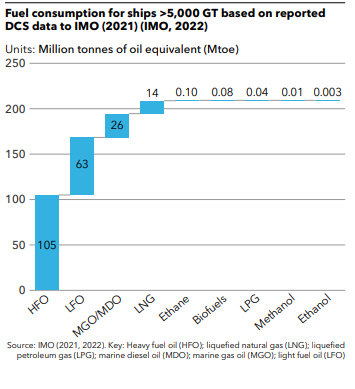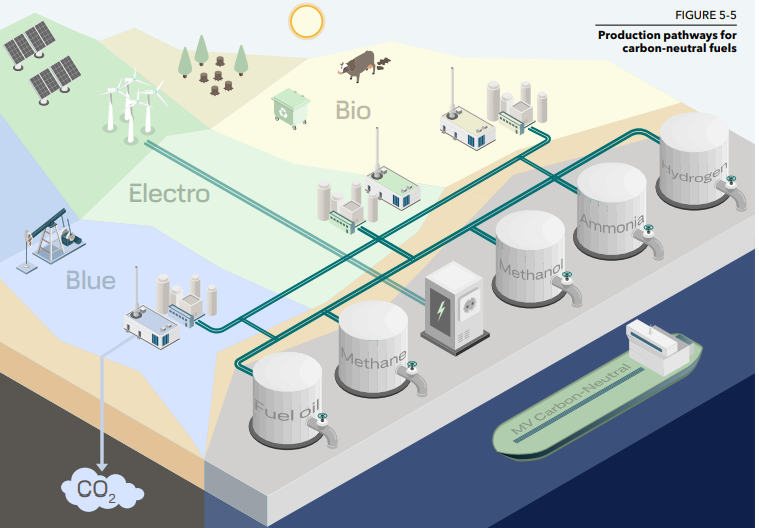In latest Maritime Forecast to 2050, DNV highlights that the availability of carbon-neutral fuels is one main concern for the shipping industry striving towards decarbonization.
According to DNV, demand for carbon-neutral fuels for all sectors will increase as local, regional, and global regulations are tightened and cargo owners require low- to zero-emission services to fulfil their own decarbonization targets.
Key findings
– The estimated demand from shipping to achieve emission reduction goals in 2030 is 30% to 40% of the total world supply of carbon-neutral fuels.
– Competition means production of carbon-neutral fuel alternatives must accelerate if emission-reduction goals are to be met.
– Price fluctuations due to supply uncertainty while production of carbon-neutral fuels ramps up mean fuel flexibility will be key for shipowners during the transition period
Existing fuel-supply chain
As informed, for 2021, the reported fuel oil consumption for ships of 5,000 gross tonnage (GT) or more in international trade was 209 Mtoe according to (IMO, 2022). Almost all (99.9%) the fuel that was reported was either heavy fuel oil (HFO), light fuel oil (LFO), marine gas oil (MGO) or liquefied natural gas (LNG). Beyond the fuel consumption reported by the IMO (2022) for ships above 5,000 GT, there is an additional amount consumed by ships of less than 5,000 GT.
The total bunker volume sold to ships in international trade was 213 Mtoe in 2019, according to sales figures from IEA. In addition to ships in international trade, there is also fuel consumption by the domestic and fishing fleet, reported by IEA as a further 57 Mtoe in 2019 (IEA, 2019). LNG consumption rose from 12.0 Mtoe in 2019 to 14.5 Mtoe in 2021 (IMO, 2022), and LNG comprises about 7% of the total fuel consumption in 2021 for ships above 5,000 GT. However, more than 95% of the LNG consumption is boil-off from the cargo on gas carriers and therefore not bunkered as fuel.
Among carbon-neutral fuels, biofuel is the most widely used in shipping today and often used as a blend-in with fossil fuels. Biofuels can be blended in with a variety of different marine fuels, such as MGO, marine diesel oil (MDO), high sulphur fuel oil (HSFO), very low sulphur fuel oil (VLSFO), and so on. The typical blending ratio of biofuel is currently in the range 20% to 30% but is also available as 100% biofuel.
As explained, the bio-blended fuels represent an available decarbonization option, as it is possible to use the infrastructure in the same way as for conventional marine bunkering fuel today. Additionally, biofuels already have an established infrastructure due to their use in multiple sectors (IRENA, 2021). For example, Port of Rotterdam sold more than 500,000 tons of bio-blended fuels in 2022 and Port of Singapore reported a sale of 140,000 tons bio-blended fuel, distributed over 90 bunkering operations86. Overall, the sales of bio-blended fuels
increased by more than 70% between 2021 and 2022.

Demand for carbon-neutral fuels in shipping
Demand for carbon-neutral fuels in shipping will be driven by GHG regulations and policies such as carbon pricing, expectations of cargo owners and consumers, and access to investors and capital. The demand for carbon-neutral fuels is therefore strongly dependent on global, regional, and national regulations. To meet defined regulatory requirements, shipping companies will seek the most economically favourable GHG emission-reduction measure at any given time. It is therefore assumed that a combination of speed reduction and energy-efficiency initiatives will ensure individual vessel compliance in the short term.
Supply of carbon-neutral fuels
According to DNV, when the shipping industry is looking ahead to 2030, two central questions are: How much of the different carbon-neutral fuels will be produced, and how much will be available for shipping? Today the supply of carbon-neutral fuels is very limited for all industries, including shipping.
Outlook on infrastructure for carbon-neutral fuels
It is essential to have sufficient infrastructure in place for distribution and bunkering. Some biofuels and electrofuels can use existing fuel oil infrastructure (bio-MGO, e-MGO) while carbonneutral liquefied methane (bio-LNG, e-LNG) can use existing LNG infrastructure. Assuming availability for such fuels, the bunkering infrastructure, distribution, and storage capabilities must be prepared for further expansion in line with demand development.































































